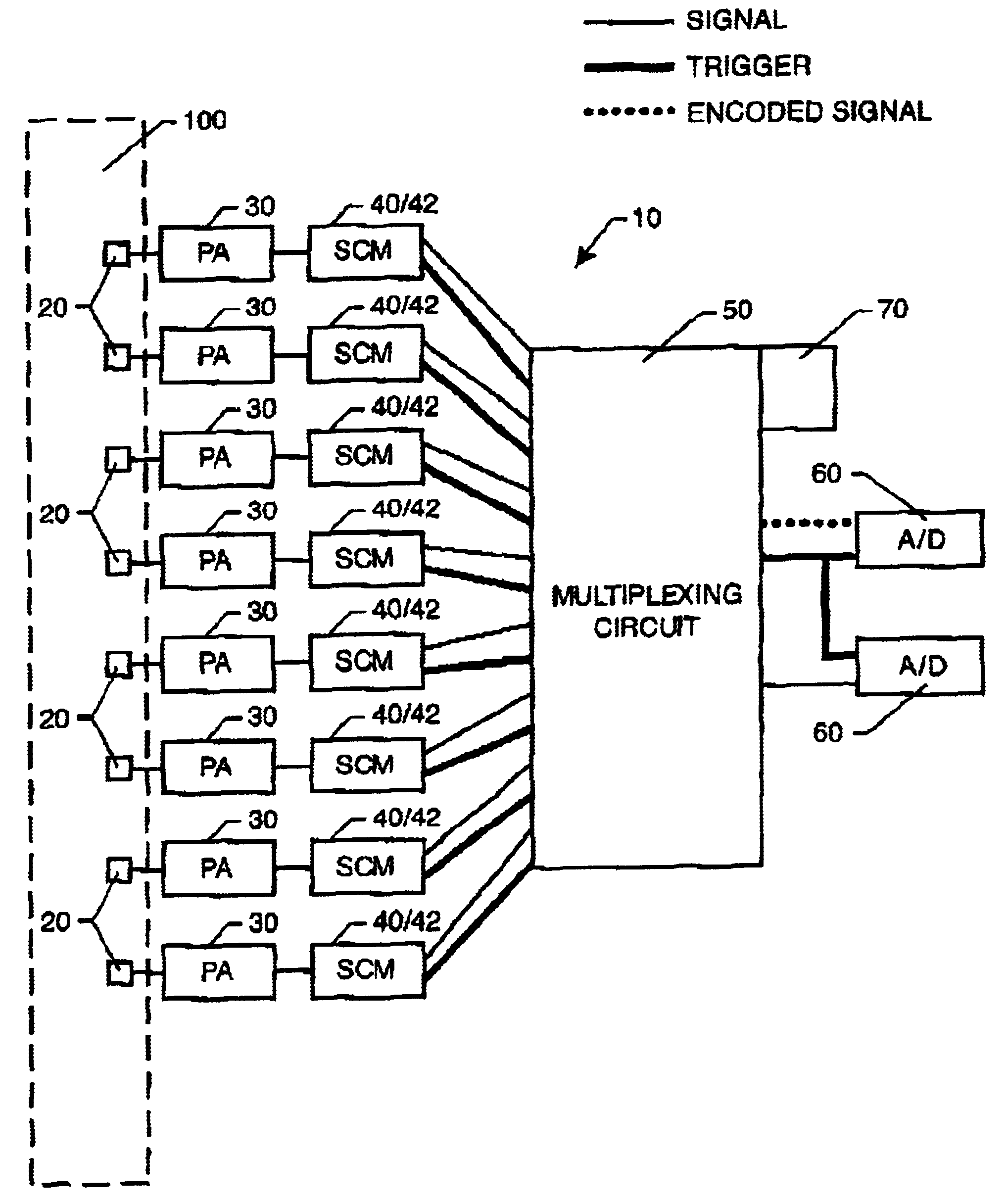System for multiplexing acoustic emission (AE) instrumentation
a technology of acoustic emission and a system, applied in the field of acoustic monitoring devices, can solve the problems of ineffective ae monitoring in monitoring acoustic, significant disadvantages of having one data acquisition channel per sensor system, and added weight, space, power, etc. to an ae system
- Summary
- Abstract
- Description
- Claims
- Application Information
AI Technical Summary
Problems solved by technology
Method used
Image
Examples
example 2
AE sensors are temporary attached in a linear array along an oil pipe. The AE sensors are attached to pre-amplifiers that connect to signal conditioning modules tied to a multiplexing circuit. As areas of the pipe begin to fail, vibrations in the form of acoustic emissions are collected by the AE sensors and amplified by the pre-amplifiers. When the acoustic emissions reach a level to cause a triggering event, the SCM relays the trigger signal to the multiplexing circuit. The multiplexing circuit rapidly switches to allow the conditioned signals from the neighboring AE sensors to be passed to the data acquisition channels. The acoustic emissions are collected from the adjacent AE sensors and recorded to determine the location and magnitude of the failing areas of the pipe.
example 3
AE sensors are permanently molded into a ship hull in a planar array. The AE sensors are attached to pre-amplifiers that connect to signal conditioning modules tied to a multiplexing circuit. As the ship hull experiences forces, the acoustic emissions are collected by the AE sensors and amplified by the pre-amplifiers. When the acoustic emissions reach a level to cause a triggering event at one of the AE sensors, the SCM relays the trigger signal to the multiplexing circuit. The multiplexing circuit rapidly switches to allow the conditioned signals from the neighboring AE sensors to be passed to the data acquisition channels. The acoustic emissions collected from adjacent AE sensors next to the triggered AE sensor are recorded to determine the location of the triggering event, and assess the likelihood of ship hull failure.
example 4
AE sensors are permanently molded into a spatial array within a solid propellent in a space shuttle. The AE sensors are attached to pre-amplifiers that connect to signal conditioning modules tied to a multiplexing circuit. Vibrations are monitored by the AE sensors and amplified by the pre-amplifiers. When the acoustic emissions reach a level to cause a triggering event at one of the AE sensors, the SCM relays the trigger signal to the multiplexing circuit. The multiplexing circuit rapidly switches to allow the conditioned signals from the neighboring AE sensors to be passed to the data acquisition channels. The acoustic emissions collected from adjacent AE sensors next to the triggered AE sensor are recorded to determine the location of the triggering event, and assess the likelihood of damage to the propellent. With the occurrence of particular triggering events, the propellent is automatically jettisoned from the space shuttle.
PUM
 Login to View More
Login to View More Abstract
Description
Claims
Application Information
 Login to View More
Login to View More - R&D
- Intellectual Property
- Life Sciences
- Materials
- Tech Scout
- Unparalleled Data Quality
- Higher Quality Content
- 60% Fewer Hallucinations
Browse by: Latest US Patents, China's latest patents, Technical Efficacy Thesaurus, Application Domain, Technology Topic, Popular Technical Reports.
© 2025 PatSnap. All rights reserved.Legal|Privacy policy|Modern Slavery Act Transparency Statement|Sitemap|About US| Contact US: help@patsnap.com


